Green Stormwater Infrastructure Tools
Overview
Trees, shrubs, perennials and grasses help manage rainwater, or stormwater, by diverting water and preventing it from becoming runoff via infiltration, evapotranspiration, and filtration. First, plant leaves, branches, and flowers catch the rain drops before the water hits the ground and becomes runoff. The stormwater collected on these surfaces can easily evaporate into the air and never have to be managed in traditional sewer and stormwater collection systems. Furthermore, plants help manage stormwater runoff by allowing water to infiltrate into the soil and by evapotranspiration, the process in which water is taken up by a plant’s roots and transpired through its leaves. Last, plants and soil also help by filtering stormwater runoff.
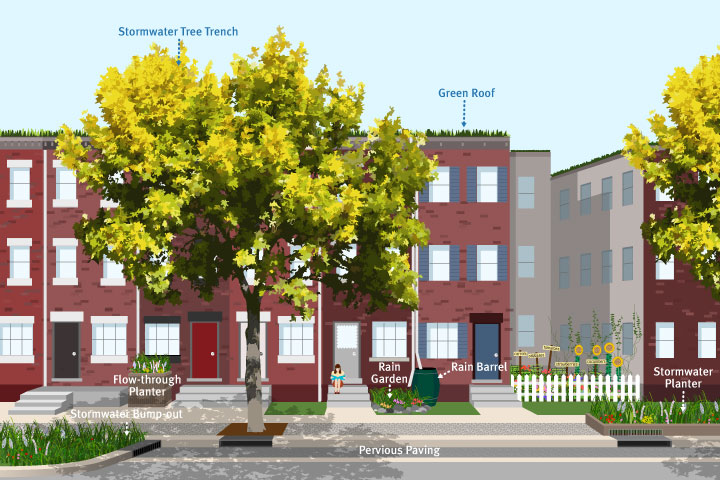
A vision of what green stormwater infrastructure tools would look like when implemented in Philadelphia's neighborhoods.
Stormwater Tree Trench
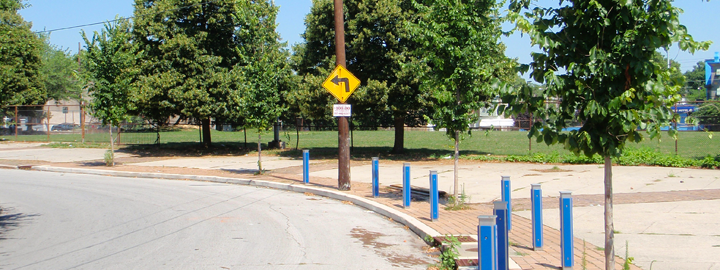
A stormwater tree trench is a system of trees that are connected by an underground infiltration structure. On the surface, a stormwater tree trench looks just like a series of street tree pits. However, under the sidewalk, there is an engineered system to manage the incoming runoff. This system is composed of a trench dug along the sidewalk, lined with a permeable geotextile fabric, filled with stone or gravel, and topped off with soil and trees. Stormwater runoff flows through a special inlet (storm drain) leading to the stormwater tree trench. The runoff is stored in the empty spaces between the stones, watering the trees and slowly infiltrating through the bottom. If the capacity of this system is exceeded, stormwater runoff can bypass it entirely and flow into an existing street inlet.
Stormwater Bump-Out

A stormwater bump-out is a vegetated curb extension that protrudes into the street either mid-block or at an intersection, creating a new curb some distance from the existing curb. A bump-out is composed of a layer of stone that is topped with soil and plants. An inlet or curb-cut directs runoff into the bump-out structure where it can be stored, infiltrated, and taken up by the plants (evapotranspiration). Excess runoff is permitted to leave the system and flow to an existing inlet. The vegetation of the bump-out will be short enough to allow for open sight lines of traffic. Aside from managing stormwater, bump-outs also help with traffic-calming, and when located at crosswalks, they provide a pedestrian safety benefit by reducing the street crossing distance.
Stormwater Planter
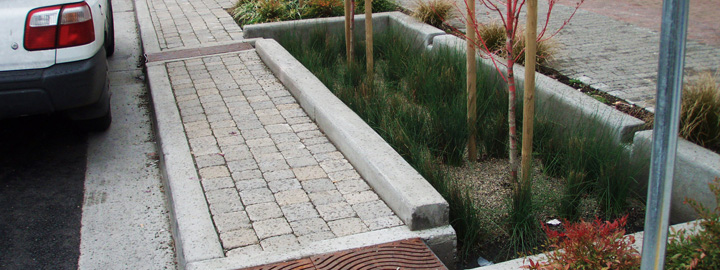
A stormwater planter is a specialized planter installed in the sidewalk area that is designed to manage street and sidewalk runoff. It is normally rectangular, with four concrete sides providing structure and curbs for the planter. The planter is lined with a permeable fabric, filled with gravel or stone, and topped off with soil, plants, and sometimes trees. The top of the soil in the planter is lower in elevation than the sidewalk, allowing for runoff to flow into the planter through an inlet at street level. These planters manage stormwater by providing storage, infiltration, and evapotranspiration of runoff. Excess runoff is directed into an overflow pipe connected to the existing combined sewer pipe.
Pervious Pavement
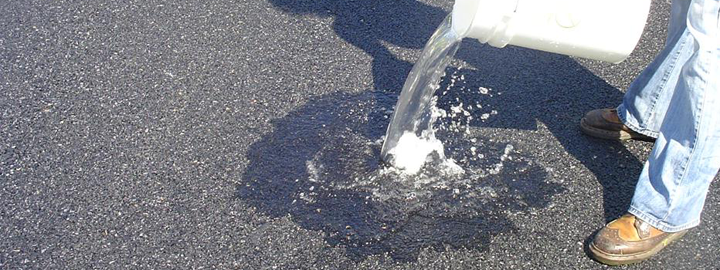
Pervious pavement is a specially designed pavement system that allows water to infiltrate through the pavement and never become runoff. This system provides the structural support of conventional pavement but is made up of a porous surface and an underground stone reservoir. The stone reservoir provides temporary storage before the water infiltrates the soil. There are many different types of porous surfaces, including pervious asphalt, pervious concrete, and interlocking pavers. Interlocking pavers function slightly differently than pervious concrete and asphalt. Rather than allowing the water to penetrate through the paving, pavers are spaced apart with gravel or grass in between to allow for infiltration.
Green Roof
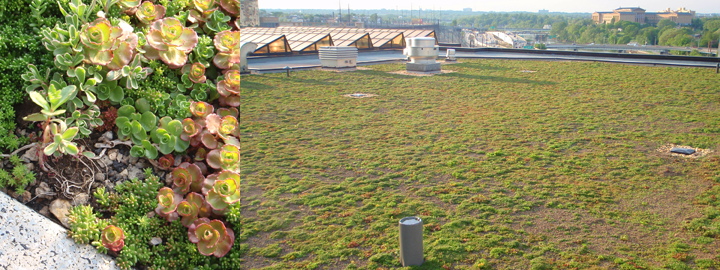
A green roof is a roof or section of roof that is vegetated. A green roof system is composed of multiple layers including waterproofing, a drainage layer, an engineered planting media, and specially selected plants. Green roofs can be installed on many types of roofs, from small slanting roofs to large commercial flat roofs. Two basic types of green roofs have been developed: extensive and intensive. An extensive green roof system is a thin (usually less than 6 inches), lighter-weight system planted predominantly with drought-tolerant succulent plants and grasses. An intensive green roof is a deeper, heavier system designed to sustain more complex landscapes. A green roof is effective in reducing the volume and velocity of stormwater runoff from roofs by temporarily storing stormwater, slowing excess stormwater release into the combined sewer system, and promoting evapotranspiration.
Rain Barrel/Cistern

A rain barrel or cistern is a structure that collects and stores stormwater runoff from rooftops. The collected rain water can be used for irrigation to water lawns, gardens, window boxes or street trees. By temporarily holding the stormwater runoff during a rain event, more capacity can be added to the city’s sewer system. However, rain barrels and cisterns only serve an effective stormwater control function if the stored water is used or emptied between most storms so that there is free storage volume for the next storm. Rain barrels are designed to overflow into the sewer system through the existing downspout connection in large storm events. Although these systems store only a small volume of stormwater, collectively they can be effective at preventing large volumes of runoff from entering the sewer system.
Rain Garden
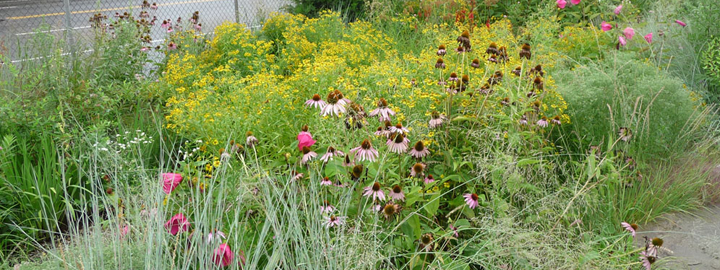
A rain garden is a garden designed to collect runoff from impervious surfaces such as roofs, walkways, and parking lots, allowing water to infiltrate the ground. The garden is normally moderately depressed (lower than the surrounding ground level), with the bottom layer filled with stone so runoff can collect and pond within it. The site is graded appropriately to cause stormwater to flow into the rain garden area from the nearby impervious area. The water ponds on the surface, is used by the vegetation in evapotranspiration, and infiltrates into the subsurface stone storage and soil. Rain gardens can be connected to sewer systems through an overflow structure, but usually they are sized to infiltrate the collected stormwater runoff within 72 hours. Flexible and easy to incorporate into landscaped areas, rain gardens are suitable for many types and sizes of development and retrofits. Rain gardens are effective at removing pollutants and reducing stormwater runoff volume.
Flow-Through Planter

A flow-through planter is a structure that is designed to allow stormwater from roof gutters to flow through and be used by the plants. Flow-through planters are filled with gravel, soil, vegetation and a connection to the roof downspout to let water flow in. They temporarily store stormwater runoff on top of the soil and filter sediment and pollutants as water infiltrates down through the planter. They are typically waterproofed, and the bottom of the planter is normally impervious. As a result, planters do not infiltrate runoff into the ground; they rely on evapotranspiration and short-term storage to manage stormwater. Excess water can overflow into the existing downspout connection. Flow-through planters can be constructed in many sizes and shapes and with various materials, including concrete, brick, plastic lumber, or wood.
For a hand-out version of this page click here: PWD's Green Stormwater Infrastructure Tools.